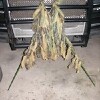I'm about to try my hand at coyote hunting. I have the call and decoy on the way. My plan is to set up on field edges with call and decoy about 100yds away.
To anybody that hunts them in the Southeast, what's your prefered strategy for this time of year?
My FX5 remote is not 100% reliable much past 50 yards and that is plenty far where I hunt. Wire fences, wet foliage, defilade, etc. can affect the radio signal.
As has been stated, enter area as quietly and unobserved as possible.
Watch your downwind, don't walk through area you plan to observe any more than necessary. Good concealment tips above, one thing that has not been mentioned, always set up in shade if available and if possible with sun directly behind you.
I like to set up with the decoy cross wind to some degree, 30-50 yards out and positioned so I can see downwind of the call/decoy.
Always carry at least one mouth call in event of malfunction of electronic call.
As has been stated, sticks or tripod are worth their weight in gold.
This time of year, I usually open with some sort of female invitational, or whimpers and end each stand with coyote pup distress. Sit a few minutes before getting up, as one will often come in late out of curiosity.
If one charges in, try to bark him to a stop once in range, but be prepared for a quick shot as they won't stand long. Any loud noise (some simply yell at them) will often result in them stopping suddenly to see what that noise was.
Watch their body language as they come in. Coming on strong, let them get closer. If they stop suddenly, turn broadside they are usually alerted and are likely to turn and run. If they stop still facing you/call, they are probably just trying to locate sound origin and will probably come a bit closer.
There is no always or never when calling critters.
I hunt pretty heavy brush, so generally don't have to walk too far from the jeep, and am able to carry a short chair, sticks, call and decoy. The chair is a necessity due to flat terrain and height of brush/grass, not to mention the fact that chair in concert with sticks is almost as steady as shooting off a bench and sandbags, and adding a bit of


ghillie netting provides a bit of cover, especially when using mouth calls.
Pretty good discussion of use of decoys here:
https://www.thehighroad.org/index.php?threads/varmint-calling-decoys-do-they-work.882152/
ETA: Also like to set up close to (inside) corners or coves in the brush line, placing decoy a few yards out in pasture (partially hidden by grass or a bush) so as to make them look for it. They will often come to the edge of the brush, but may be reluctant to come out into the clearing sometime offering a shot if you can see a few feet back into the brush.
Have fun!
Regards,
hps



